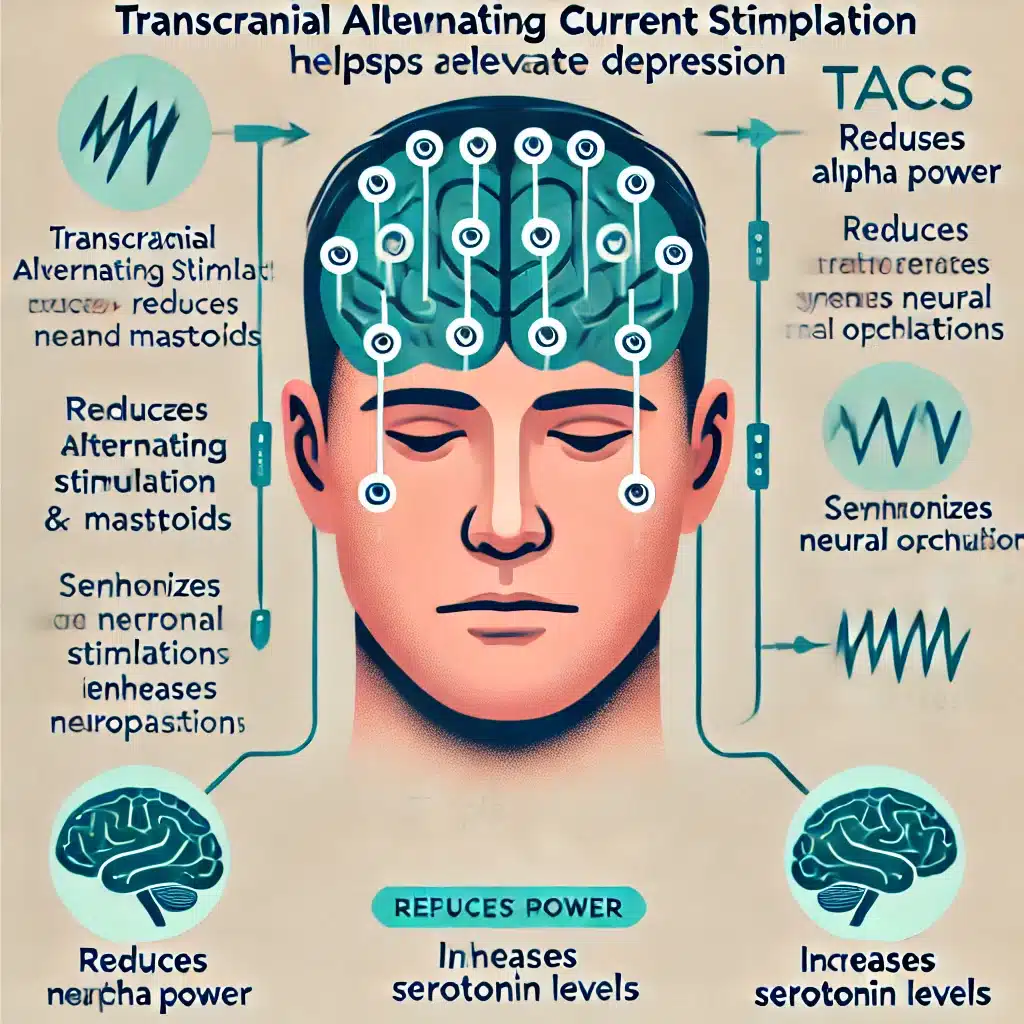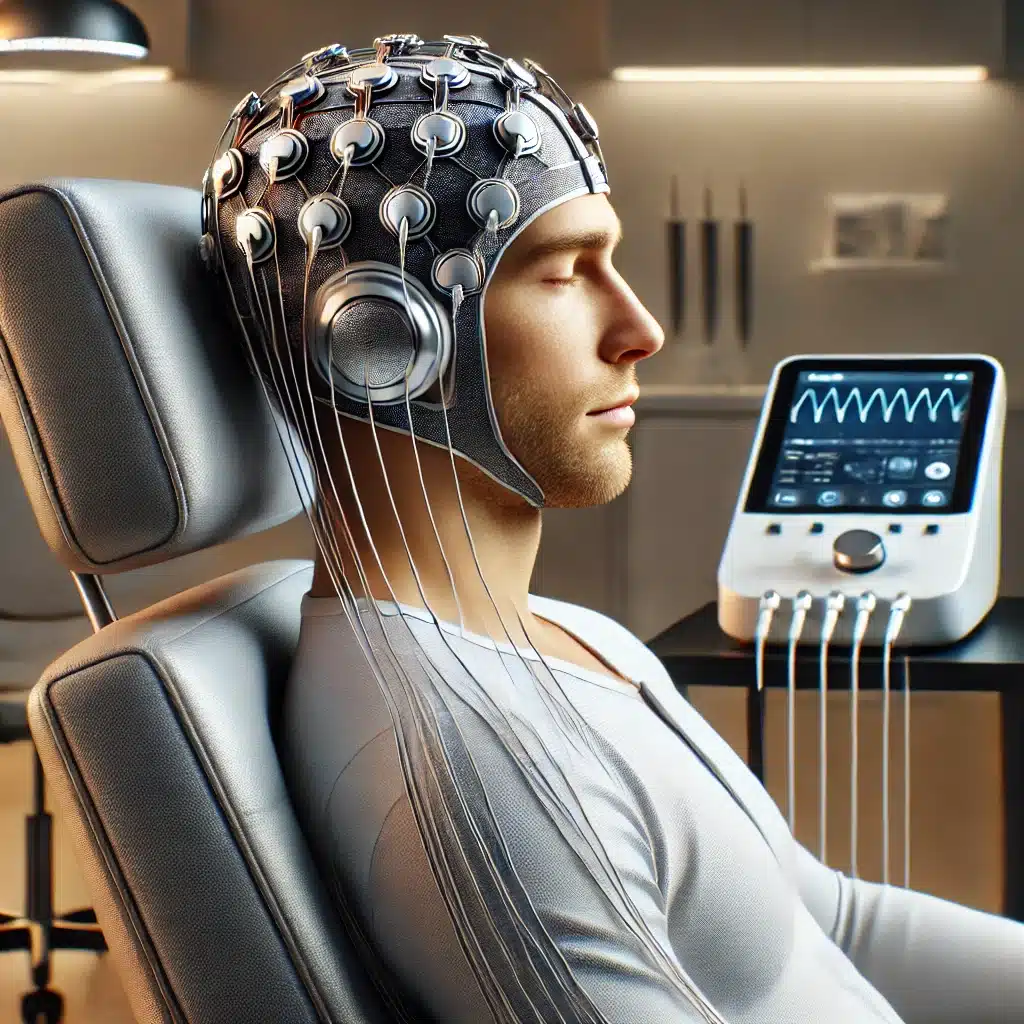Adding transcranial alternating current stimulation (tACS) to antidepressant treatment improves depression symptoms more effectively than using antidepressants alone.
Highlights:
- Enhanced Efficacy: tACS combined with antidepressants significantly reduces depression symptoms compared to antidepressant treatment alone.
- Lasting Effects: The additional antidepressant benefits of tACS persist for at least 4 weeks after treatment ends.
- Brain Activity Changes: Patients who responded to tACS showed a decrease in alpha power in the left frontal lobe, a change linked to the treatment’s effectiveness.
- Safety: tACS was well-tolerated with no serious adverse events reported, making it a feasible add-on therapy for depression.
- Mechanism: The antidepressant effects of tACS may be due to its ability to reduce alpha power in the left frontal region of the brain, which is associated with improved mood and cognitive function.
Source: Brain Stimulation (2024)
Major Findings: Transcranial Alternating Current Stimulation for Depression as Adjunct (2024)
1. Enhanced Efficacy of tACS as an Add-on Treatment
Improved Depression Scores
Patients who received tACS in addition to their antidepressant medication showed significantly greater improvements in their depression symptoms.
This was measured using the 17-item Hamilton Rating Scale for Depression (HAMD-17), where the scores of the tACS group reduced more than the sham (placebo) group.
Higher Response Rates
By Week 4, 66.7% of patients in the tACS group had a clinically meaningful response to treatment, compared to 33.3% in the sham group.
This response is defined as a reduction of at least 50% in the HAMD-17 scores.
2. Long-lasting Effects
Persistent Improvement
The additional antidepressant effects of tACS were not just temporary.
Patients continued to experience the benefits for at least 4 weeks after the treatment sessions ended, indicating lasting improvements in depression symptoms.
3. Changes in Brain Activity
Alpha Power Reduction
Responders to the tACS treatment exhibited a significant decrease in alpha power in the left frontal lobe of the brain.
Alpha power is a type of brain wave activity, and its reduction in the left frontal area is associated with alleviation of depressive symptoms.
Correlation with Clinical Improvement
There was a notable correlation between the reduction in alpha power and the improvement in depression scores, suggesting that the changes in brain activity were directly linked to the therapeutic effects of tACS.
4. Safety & Tolerability
No Serious Adverse Events
Throughout the study, no serious side effects were observed, and the treatment was well tolerated by patients.
Mild side effects reported included headaches, drowsiness, and dizziness, but these were not severe enough to cause concern.
Completion Rate
The majority of participants (86.4%) completed the 4-week study, further indicating that tACS is a feasible and tolerable treatment option when combined with antidepressants.
5. Potential Mechanism of Action
Targeted Brain Modulation
The study suggests that the antidepressant effects of tACS might be due to its ability to modulate brain activity, particularly by reducing alpha power in the left frontal lobe.
This area of the brain is crucial for mood regulation and emotional processing, and its normalization could help alleviate depressive symptoms.
TACS Protocol Used in the Study (Specifics)

1. Stimulation Parameters
- Frequency: 77.5 Hz
- Current Intensity: 15 mA (amplitude reported as zero-to-peak)
- Waveform: Square waves with ramp-up and ramp-down periods of 180 and 12 seconds, respectively
2. Electrode Placement
- Forehead Electrodes: One 4.45 × 9.53 cm electrode placed at Fpz, with additional placements at Fp1 and Fp2 according to the 10/20 international placement system.
- Mastoid Electrodes: Two 3.18 × 3.81 cm electrodes placed on each side of the mastoid.
3. Treatment Schedule
- Session Duration: 40 minutes per session
- Frequency of Sessions: Daily, from Monday to Friday
- Total Number of Sessions: 20 sessions over a period of 4 weeks
- Follow-Up Period: Participants were monitored for an additional 4 weeks post-treatment without further tACS sessions.
4. Concurrent Antidepressant Medication
- Participants took 10-20 mg of escitalopram daily.
- The initial dose was 5 mg/day, which could be increased to 10 mg/day after 4 days and potentially to 20 mg/day based on the patient’s condition.
5. Blinding & Sham Control
Blinding: Both the participants and researchers were blinded to the treatment assignments (active or sham tACS). The sham tACS devices were designed to mimic the sensations of active stimulation without delivering actual therapeutic current.
Sham Protocol: Sham tACS involved no active stimulation but maintained the same setup and duration as the active tACS sessions to ensure the blinding integrity.
How TACS May Treat Depression (Possible Mechanisms)

Transcranial alternating current stimulation (tACS) is thought to help alleviate depression through several specific mechanisms related to brain activity modulation:
1. Modulation of Alpha Brain Waves
tACS has been shown to reduce alpha power in the left frontal lobe, which is associated with depressive symptoms.
Elevated alpha power in this region is linked to neuronal hypoactivity and reduced emotional processing.
By decreasing alpha power, tACS may help normalize brain activity, thereby alleviating depressive symptoms.
2. Entrainment of Neural Oscillations
Synchronization: tACS delivers alternating electrical currents that can synchronize with and modulate the brain’s natural oscillatory rhythms. This entrainment can enhance neural connectivity and improve the coherence of brain network activity, which is often disrupted in depression.
Restoration of Balance: By targeting specific frequencies, tACS can help restore the balance of neural oscillations, promoting healthier brain function and reducing symptoms of depression.
3. Spike-Timing Dependent Plasticity (STDP)
tACS can induce long-term changes in synaptic strength through STDP, where the timing of neuronal spikes is crucial for synaptic modification.
This process can enhance the plasticity of neural circuits involved in mood regulation, potentially leading to more sustained improvements in depressive symptoms.
4. Neurotransmitter & Endorphin Modulation
tACS at certain frequencies has been found to increase the levels of endorphins and neurotransmitters such as serotonin in various brain regions, including the cortex and brainstem.
These neurochemical changes can improve mood and reduce depressive symptoms by enhancing the overall neurochemical environment.
5. Prefrontal Cortex Activation
The left prefrontal cortex is critical for mood regulation and cognitive functions. tACS can specifically target this area, improving its activity and connectivity.
Enhanced prefrontal cortex function is associated with better emotional processing and reduced depressive symptoms.
6. Calming Neural Hyperactivity
In depression, certain brain regions may become hyperactive, leading to increased negative thinking and emotional distress.
tACS can help calm this hyperactivity, promoting a more balanced and less distressing mental state.
Trial Details: TACS for Major Depressive Disorder (2024)

The aim of this study was to evaluate the feasibility, safety, and efficacy of transcranial alternating current stimulation (tACS) as an add-on treatment for major depressive disorder (MDD) and to understand its impact on brain activity.
Sample
- Participants: 66 patients with MDD
- Demographics: Mean age of 28.4 years; 78.8% female
- Groups: Randomly assigned to active tACS (n=33) or sham tACS (n=33)
Methods
- Design: 4-week, double-blind, randomized, sham-controlled trial
- Intervention: 20 sessions of 40-minute tACS (77.5Hz, 15 mA) or sham stimulation over 4 weeks
- Antidepressant: All participants took 10-20 mg of escitalopram daily
- Follow-up: Participants were monitored for an additional 4 weeks post-treatment
- Primary Outcome: Change in HAMD-17 scores from baseline to Week 4
- Secondary Outcome: Resting-state electroencephalography (EEG) to measure alpha power changes
Limitations
- Short Follow-Up Period: The study only included a 4-week follow-up, limiting the assessment of long-term effects.
- Fixed Parameters: Only one tACS frequency and current intensity were tested, which may not be optimal for all patients.
- Combined Treatment Effects: All participants used antidepressants, potentially confounding the specific effects of tACS.
- Sample Size and Generalizability: The relatively small sample size and specific inclusion criteria limit the generalizability of the findings to a broader population.
- Dropout Rates: Higher dropout rates in the sham group could have impacted the results.
How to Safely Try tACS for Depression
1. Consult with a Healthcare Provider
Always seek advice from a mental health professional before starting any new treatment for depression.
They can assess your specific condition and determine if tACS is appropriate for you.
Discuss how tACS might complement your current treatment plan, whether as a standalone therapy or in conjunction with other treatments like antidepressants.
2. Find a Reputable Clinic or Provider
Look for clinics or providers specializing in neuromodulation therapies and ensure they have experience with tACS.
Check for reviews and testimonials from other patients to gauge the effectiveness and quality of care at the clinic.
3. Understand the Protocol
Work with your provider to develop a personalized tACS treatment plan, which includes the frequency, duration, and intensity of sessions.
Ensure the clinic follows established safety protocols and makes you feel comfortable during treatment sessions.
4. Monitor & Track Progress
Have regular check-ins with your provider to monitor the progress and adjust the treatment plan as needed.
Keep a journal of your symptoms and any changes you notice in your mood or overall well-being.
5. Consider Home-Based Options
If a clinic visit is not feasible, look for FDA-approved tACS devices designed for home use.
Ensure you follow the manufacturer’s instructions and guidelines carefully.
Even with home-based devices, it’s crucial to have regular check-ins with a healthcare provider to monitor your progress and ensure the treatment is effective and safe.
6. Stay Informed & Safe
Stay updated on the latest research and advancements in tACS to ensure you are receiving the most effective and up-to-date treatment.
Always follow safety precautions and immediately report any adverse effects or concerns to your provider.
7. Adjunct Use
Combination Therapy: If using tACS as an adjunct to antidepressants, ensure the combined approach is monitored closely by a healthcare provider.
Dosage and Frequency: Adhere to the prescribed dosage and frequency of both tACS and antidepressant medications.
Consistency: Maintain consistency in your treatment sessions and medication to achieve the best results.
Conclusion: TACS for Depression as Adjunct
References
- Study: Effect of add-on transcranial alternating current stimulation (tACS) in major depressive disorder: A randomized controlled trial (2024)
- Authors: Jingjing Zhou et al.







